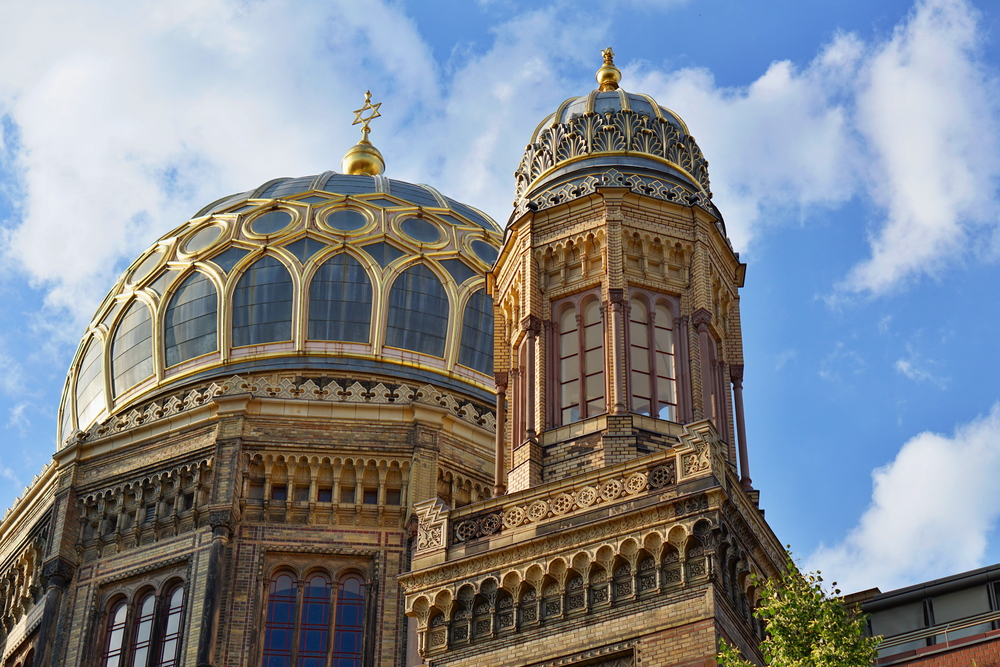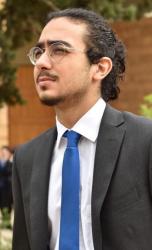Berlin is a city saturated with history. Everywhere—on every corner, in every park, behind every wall and in every building—one stumbles on a piece of that which once was, scattered by the wind of time and silently reminding the indifferent faces of the weight of the past. “Let the dead bury their dead” (Luke 9:60), it is said, for “God is not the God of the dead, but of the living” (Matt. 22:32–34). In Berlin, the dead and the living live side by side, and what is buried anxiously watches over the unfolding of the centuries, afraid to be summoned once again. And so, in the sweet and heavy lethargy of the summer, under the bright and shining sun that rises on the virtuous and the wicked alike, Berlin lives, drunk with freedom, while in the shadow of the linden the wind blows, carrying the anxious and tireless cry of the many who shall not be forgotten. Nie wieder, say they. “Never again.”
Rising above the city, a couple of blocks away from the Spree River, a dome imposingly shines in the sunlight, bright as a giant crown on the land of poets and thinkers. Blazing with gold and blue, it stands in sharp contrast with the seemingly random collection of concrete blocks hiding shamefully under the linden’s shadow, back in the city center. This blazing dome, for everyone to see, is the Neue Synagogue, the new synagogue. The concrete blocks are the Holocaust memorial.
Consecrated in 1866, the Neue Synagogue was to serve as the main place of worship for the Berlin Jewish community. Inaugurated on the Oranienburger Strasse in the presence of Otto von Bismarck, then minister president of Prussia, it stood for decades as a symbol of the city’s new commitment to coexistence. Then the war came, and then another one, barbarism triumphed for a while, and for some time the prayers ceased and silence reigned. And while in the camps and the forests six million mirrors were held to civilization’s face, there, on the Oranienburger Strasse, on the synagogue’s front, one could still read, written in golden Hebrew letters: “Open the gates that the righteous nation may enter, the nation that keeps faith” (Isa. 26:2).
It would be easy to see in the inauguration of the Neue Synagogue in 1866 and its desecration during World War II the two disconnected and radically antagonist manifestations of the commitment to and rejection of tolerance. Since the building of the synagogue, one might argue, was in its very essence a tolerant act stemming from a tolerant intention, then its desecration, rightfully regarded as an intolerant act, must likewise find its sources in a wholly opposed philosophical paradigm. In other words, the conception of tolerance that led to the building of the synagogue cannot have anything to do with the ideas that ultimately led to its looting and burning.
I believe this is ultimately mistaken. To be clear, I do not think that the destruction of the synagogue can be regarded as a tolerant act similar to its construction. I am, however, convinced that the emergence of the intolerant rage that led to the systematic murder of German and European Jews and other minorities can be traced back to the limitations inherent to the very conception of “tolerance” dominant in mid-19th- and early-20th-century Europe.
As argued by John R. Bowlin, dean of Princeton University’s Theological Seminary, in his article “Tolerance among the Fathers” in 2006, the necessity of tolerance emerges from the problem of association generated by the diversity of goods and preferences within pluralistic societies. The general occurrence of this problem has led to a traditional depiction of tolerance as a “natural” secondary virtue and an integral part of justice, such that, as put by Bowlin, “in every place and at all times the just act tolerantly, and the tolerant act justly.”
This traditional conception of tolerance as an integral component of justice presupposes an objective standard of justice, and thus the existence of an objective truth. Therefore, Cardinal Lercaro argues in his essay “Religious Tolerance in Catholic Tradition” in 1961, tolerance should not amount to mere practical foresight, but “should proceed from respect for the truth and the manner in which the human intellect arrives at the truth.” Consequently, while tolerance requires reverence for freedom as the “manner” in which human beings seek and eventually recognize the truth, it does not exist for the sake of freedom itself, nor for its own sake. Thus, it is not a virtue in and of itself but subordinated to a greater good—i.e., “the need for truth to be freely accepted as such.” This conception was, as explained by Cardinal Lercaro, implicitly present in Christian philosophy since the early Church and found its metaphysical justification in the principle of correspondence between human law and divine law.
For example, in his Summa Theologica, Thomas Aquinas enounces the principle that, since God allows the occurrence of evil in the universe so that “the suppression of evil may not entail the suppression of greater goods or even beget greater evils,” the Church, correspondingly, and “while not conceding any right to anything save what is true and honest,” “should not forbid public authority to tolerate what is at variance with truth and justice for the sake of avoiding some greater evil or preventing some greater good” (Leo XIII, Libertas, 1888). It follows that the duty to repress moral and religious error cannot, as expressed by Pope Pius XII in an address to Italian Catholic jurists on December 3, 1953, become the absolute and unconditional norm of action, as articulated by the parable of the wheat and the tares in Matt. 13:24–30.
Therefore tolerance, while incompatible with an acceptance of the wrong as such, permits it for the sake of the greater good, namely the preservation of the divinely ordained right of each individual to freely come to the truth. Tolerance so defined is thus a subtle combination of dogmatic intolerance—since truth is objective, one, and eternal—and practical license, distinguishing the defense of freedom from the “religion of freedom,” and the “liberty of consciences” from the “liberty of conscience,” as outlined by Pope Pius XI in his encyclical Non Abbiamo Bisogno in 1931.
While tolerance as defined in Catholic thought is not merely a compromise but the logical consequence of the nature of truth, the popular and dominant definition of tolerance, rooted in relativist and naturalist thought, and expressed in the construction of the Neue Synagogue in 1866, cannot amount to anything more than mere compromise. Indeed, when truth is uprooted as the purpose of freedom, then freedom is left existing alone and for its own sake, replacing truth as the supreme value. It follows that freedom becomes the sole measure by which an opinion can be evaluated, automatically excluding any recourse to an external objective standard. This is what is referred to by Pius XII as “the religion of freedom” and by Bowlin as “moral collapse.” The latter is the beginning of resentment and, ultimately, the end of freedom.
Indeed, in a society dominated by moral relativism, freedom itself ceases to be regarded as an objective value and must at best find its justification in practical circumstances. Resentment then emerges from the mere act of tolerance, which becomes nothing more than tactical restraint. In such a society, “liberty of conscience” is thus akin to liberty from the truth.
The Berlin Jews, then, were most probably not “tolerated” in a majority Christian society out of reverence for the need for truth to be freely chosen. Rather, they were tolerated because it was seen as a practical necessity. This, as history has shown, is never enough to ensure that tolerance will be preserved. If freedom is respected not as a requirement for truth but as long as it appears necessary, then it can be taken away when it ceases to be regarded as such. The modernist conception of tolerance, deprived of the telos of truth and justice and deeply relativistic in nature, contains the seeds of its own destruction, and it can be argued that the premises that led to the building of the Neue Synagogue might have been, from the beginning, rotten with the germs of their own demise.
It is therefore vital, when we speak of and strive for tolerance, to clarify what we mean by it. It seems clear that the imperative of tolerance requires—to preserve its substance and lead to constructive engagement with other belief systems—a linkage to the objective categories of truth and justice. The answer to the relativistic and resentful turn induced by the modernist conception thus seems to lay, at first hand, in a return to the Catholic understanding of tolerance as developed by the Church. However, this traditional conception of tolerance is not necessarily unique to Catholicism or even Christianity. After all, God-given individual freedom, human dignity, objective truth, and natural justice are central assumptions of all three major Abrahamic religions.
In the increasingly pluralistic and secular West, a rediscovery of the Abrahamic understandings of tolerance is necessary to prevent moral relativism, overcome resentment, and rehabilitate the traditional conception of tolerance as a consequence of man’s natural right to seek the truth. So that, in God’s good time, the gates may safely be open again.

